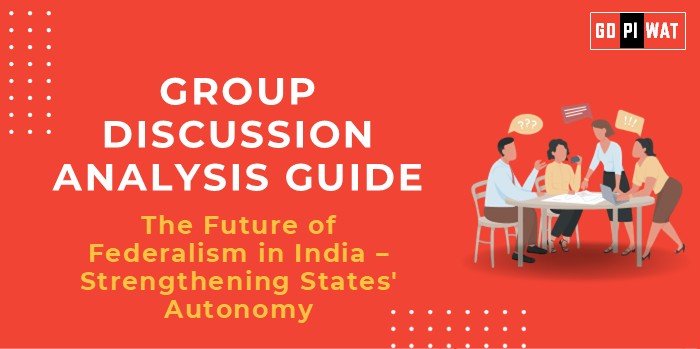📋 Group Discussion Analysis Guide
🌟 Topic: The Future of Federalism in India – Strengthening States’ Autonomy
🌐 Introduction to the Topic
Opening Context: “Federalism, the cornerstone of India’s democratic framework, balances central authority with state autonomy. With rising demands for greater decentralization, the future of federalism in India hinges on strengthening states’ powers within a cohesive national framework.”
Topic Background: Federalism in India, established by the Constitution in 1950, allocates power between the Union and state governments. While it ensures unity in diversity, tensions arise over resource allocation, policy priorities, and legislative authority. Recent debates, like the GST implementation and agricultural reforms, highlight the need to recalibrate the federal balance.
📊 Quick Facts and Key Statistics
- Constitutional Basis: Articles 245–255 define the legislative powers of Union and States.
- Fiscal Federalism: The 15th Finance Commission recommended that states receive 41% of the divisible tax pool for 2021–26, a reduction from 42% in the 14th Finance Commission’s period.
- Regional Disparities: Southern states contribute significantly to India’s tax revenues but receive a smaller share in fiscal allocations, sparking perceptions of inequity.
- Policy Autonomy: Many states advocate for greater autonomy in education and health policies to address regional needs better.
- GST Collections: Over ₹1.5 lakh crore/month, centralizing tax revenue under a uniform system.
👥 Stakeholders and Their Roles
- Union Government: Ensures national unity and manages concurrent subjects like education, health, and infrastructure development.
- State Governments: Advocate for decentralized governance to address local needs effectively.
- Judiciary: Mediates disputes between the Centre and states (e.g., Delhi government’s powers).
- Civil Society and Media: Highlight regional grievances and advocate for equitable federal practices.
🏆 Achievements and Challenges
✅ Achievements:
- Fiscal Devolution: Enhanced state revenues through GST and Finance Commission recommendations.
- Empowered States: Success stories like Kerala in health and Tamil Nadu in education highlight state-led innovation.
- Collaborative Mechanisms: Institutions like NITI Aayog promote cooperative federalism.
⚠️ Challenges:
- Centralization of Power: Dominance of centrally-sponsored schemes limits states’ autonomy.
- Revenue Imbalances: Reduction from 42% to 41% in the divisible pool allocation impacts state finances.
- Policy Tensions: Conflicts on agricultural laws and language policies reveal federal strains.
🌍 Global Comparisons
- USA: Clear separation of federal and state powers, fostering competition and innovation.
- Germany: A strong cooperative federalism model ensures state equity.
📌 Case Study:
Tamil Nadu’s autonomy in health: Establishment of primary health centers reduced maternal mortality rates by 60% over two decades.
💡 Structured Arguments for Discussion
- Supporting Stance: “Strengthening states’ autonomy fosters localized solutions and promotes innovation tailored to regional needs.”
- Opposing Stance: “Excessive state autonomy could fragment national unity and create policy inconsistencies.”
- Balanced Perspective: “Empowering states while retaining a robust national framework ensures balanced governance.”
🚀 Effective Discussion Approaches
- Opening Techniques:
- Quote: “As Dr. B.R. Ambedkar noted, ‘India is a Union of States, not a federation.’ This subtle distinction guides our federal ethos.”
- Statistics: “With 41% tax devolution under the 15th Finance Commission, states increasingly demand greater fiscal autonomy to address local priorities.”
- Counter-Argument Handling:
- Point: Revenue centralization under GST limits states’ powers.
- Rebuttal: Uniform tax rates simplify trade and promote economic growth.
🔍 Strategic Analysis of Strengths and Weaknesses
- Strengths: Regional innovation, economic decentralization.
- Weaknesses: Policy conflicts, fiscal inequities.
- Opportunities: Public-private partnerships, digital governance initiatives.
- Threats: Regional disparity, political polarization.
🌟 Connecting with B-School Applications
- Real-World Applications: Policy-making, operations in diverse regulatory environments.
- Sample Questions:
- “How does fiscal federalism impact India’s economic growth?”
- “What lessons can India draw from global federal models?”
- Insights: Federalism’s role in enhancing business opportunities and governance innovation.


